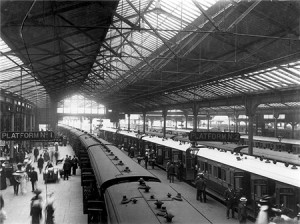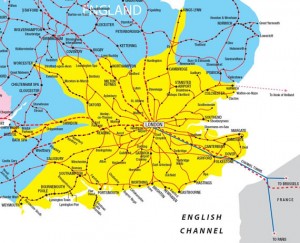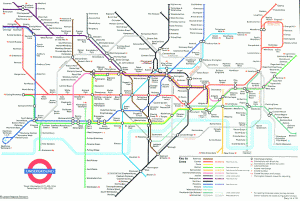Navigating the spider web
When Tony and I finally arrived in London after our weeks-long journey, our college friends Bill Moore and Robert Ludbrook met us at Waterloo Station. I felt like hugging them both, but thought they might be embarrassed, I wrote in my notes. New Zealand men of our time did not go in for overt displays of emotion.

An early 20th century view of Waterloo Station. It looked much the same in 1962. Image from http://www.heritage-explorer.co.uk/
Robert spoke of his and his wife Miriam’s “traumatic experience” when they arrived. They sat for three hours in the huge Waterloo station, not knowing whether they were on the right platform, not sure what to do, or even if they could get to Derby, in the middle of the country, where Miriam’s parents lived. Their ten-month-old baby was crying from hunger – none of them had eaten for three hours. They knew no-one in the city. “I decided then that no-one I called my friend should suffer the same fate,” Robert said.
Waterloo Station is part of a transportation network that on a map looks like a giant spider web with the heart of London at its center.
The trains link to London’s famous Underground system, with which I became very familiar in the next few weeks as I searched for short-term accommodation while Tony job-hunted. I found these notes in my black filing cabinet:
Several days [after our arrival] I returned to Waterloo, and could not remember ever having seen the concourse of the station before, yet we must have passed through it on our way to the underground platform. I can remember the way the train came into the main platform – rows of long platforms jutting out into the track, with the entrance at the head of them, and the high wrought iron and glass ceiling, very dirty, overhead.
And I can remember standing on the underground platform, although that memory rapidly becomes confused with standing on other underground platforms, all confusingly similar. Always the same smell, compounded of dust and disinfectant and human bodies, always the same roar of the escalators, the same draughts of air rushing in or out, and the airless feeling when a train has passed, the rattle and screech of the trains grating on the ear-drum and jangling the nerves. The hypnotic movement, grinding to a halt at stations, and the doors swishing open. Some go in and some go out, but they are always the same people.
It is very easy to miss your own station if you do not concentrate very hard. The signs are easy to follow – in the station itself you do not get lost unless you are very blasé and think you know where you are going – but all the stations appear exactly the same – it is just that in each the maze of tunnels is different. But once on the right train you feel that you are safe, that you can relax for a while from the struggle of finding your way about. This is the most dangerous of all, as before you know what has happened, the train will have swished past your station while you were still dreaming.


So scary. Your poor friends. Three hours of torture!
Ah, yes, my nightmare in a nutshell. Being lost in the underground rail system of a city I don’t know.